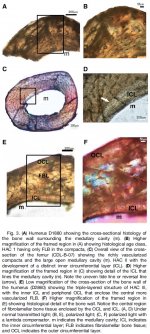Fred Ruhe
Well-known member

Anusuya Chinsamy, Jesús Marugán‐Lobón, Francisco J. Serrano & Luis Chiappe, 2019
Osteohistology and life history of the basal pygostylian, Confuciusornis sanctus
The Anatomical Record. in press.
doi:10.1002/ar.24282
Abstract: https://anatomypubs.onlinelibrary.wiley.com/doi/abs/10.1002/ar.24282
More than a thousand specimens of Confuciusornis sanctus have been recovered from the Early Cretaceous Jehol Group of Northeastern China. Here, we investigate the bone microstructure of 33 long bones sampled from 14 C. sanctus specimens in an attempt to assess the life history patterns of this basal pygostylian bird. Analysis of the histology of various skeletal elements (femur, humerus, tibia, radius, and ulna) revealed differences in the histology of their bone walls. Based on the osteohistology, we coded the examined specimens into five histology age classes. We found that histological age was not strictly correlated with body size. The variability in the histology of multiple bones from single skeletons suggests differences in the growth rate of the skeleton in response to allometry, functional demands, and pathology. We show that although fibrolamellar bone is widespread across birds, the extent and duration of this rapid phase of bone deposition is highly variable. Comparisons among Mesozoic birds confirm that early ontogenetic growth was rapid, but that later post‐hatching growth was strongly influenced by the ontogenetic age of the individual, body size, and local environment, as well as taxonomy. Our findings indicate that C. sanctus experienced rapid growth from early ontogeny until almost fully grown, and thereafter transitioned to slow, episodic growth (for at least 3–4 years) to reach skeletal maturity. Anat Rec, 2019. © 2019 American Association for Anatomy.
Enjoy,
Fred
Osteohistology and life history of the basal pygostylian, Confuciusornis sanctus
The Anatomical Record. in press.
doi:10.1002/ar.24282
Abstract: https://anatomypubs.onlinelibrary.wiley.com/doi/abs/10.1002/ar.24282
More than a thousand specimens of Confuciusornis sanctus have been recovered from the Early Cretaceous Jehol Group of Northeastern China. Here, we investigate the bone microstructure of 33 long bones sampled from 14 C. sanctus specimens in an attempt to assess the life history patterns of this basal pygostylian bird. Analysis of the histology of various skeletal elements (femur, humerus, tibia, radius, and ulna) revealed differences in the histology of their bone walls. Based on the osteohistology, we coded the examined specimens into five histology age classes. We found that histological age was not strictly correlated with body size. The variability in the histology of multiple bones from single skeletons suggests differences in the growth rate of the skeleton in response to allometry, functional demands, and pathology. We show that although fibrolamellar bone is widespread across birds, the extent and duration of this rapid phase of bone deposition is highly variable. Comparisons among Mesozoic birds confirm that early ontogenetic growth was rapid, but that later post‐hatching growth was strongly influenced by the ontogenetic age of the individual, body size, and local environment, as well as taxonomy. Our findings indicate that C. sanctus experienced rapid growth from early ontogeny until almost fully grown, and thereafter transitioned to slow, episodic growth (for at least 3–4 years) to reach skeletal maturity. Anat Rec, 2019. © 2019 American Association for Anatomy.
Enjoy,
Fred




